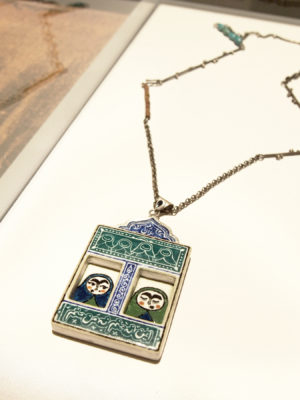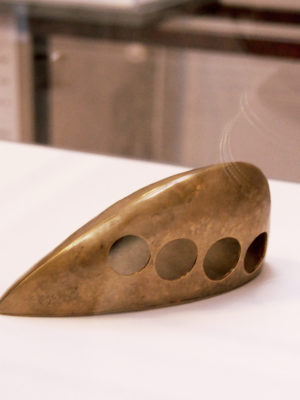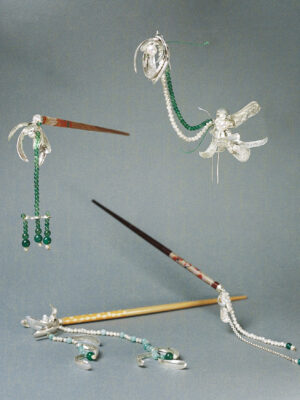Kellie Riggs: How did your interest in contemporary Iranian and Persian jewellery begin, or where did you first encounter work from there?
Kevin Murray: I was invited onto a jury for the World Crafts Council program for World Cities of Craft to assess applications from Tabriz (carpets) and Mashaad (turquoise). Doing a workshop in Mashaad, I met the local jeweller Baharak Omidfar, who impressed me with the ambition of her work. I’d also heard that there was an institute in Tehran and made contact with them. I ended up doing a workshop there and staying for the week at Mahe Mehr Institute. It’s hard not to be charmed by Iranians once you’ve spent a little time there. Their enthusiasm for the new field of contemporary jewellery was infectious, and I felt that I could play a role as an international curator in making connections with the broader field.
Can you tell us a little bit about Aria gallery and what kind of work and artists they represent?
Aria Gallery represents a diverse range of artists. They often host international artists and provide an important point of exchange for the local scene. Aria Eghbol travels quite widely and takes great responsibility in uplifting the local scene.
What does Eastern work in the jewellery field bring to the table that perhaps we haven’t seen in Western contemporary jewellery? Or what have you found to be special about what you’ve seen?
I think it’s natural in any field that it can begin to be a little inward looking after its development phase. The West has a strong contemporary jewellery field with galleries, events and museums, which we can tend to take for granted. As an emerging region, the East does help us look afresh at the field. It’s inspiring to see those who do not have the established infrastructure show such determination to pursue this practice.
In addition, I think the Eastern approach does tend to look more to tradition. There is a more collective sense of identity and pride in the shared history. It is less about the creative freedom of the individual, which characterises much of the West. I think Buddhism offers an important context for jewellery with the emphasis it places on contemplation.
Why is “Contemporary Jewellery” generally considered a western phenomenon anyway? Is by definition (as a proper noun rather) seen as more academic than it is cultural?
My point is that it need not be a Western phenomenon. Historically, the West is the origin of modernism, which applies to jewellery as it does to other art forms. And as with most “contemporary” art practices, it tends to be divorced from popular audiences. The critical reflection on the world will always be a marginal activity, by nature. But I do think it’s important that we attempt to connect with the popular audience, particularly given the pervasiveness of body ornament in everyday life. This carries forward the Dutch emphasis on the democratic imperative in contemporary jewellery.
Is there a more profound cultural relevancy found in work from Iran than you’ve noticed in some European work? I ask because the art world, and jewellery as well, has experienced its own kind of globalization. It’s more and more difficult to trace cultural threads in work that comes out of various international academies because more and more international students are travelling far for their education. In this sense is Iranian work refreshing?
Yes, there’s the sense of a real cultural project at play in Iran at the moment. This is partly in response to an otherwise heavy-handed theocracy. The diversity of Iranian history over millennia belies the rigid codes that are promulgated from above today. The position of women in Iran seems especially relevant to jewellery, where it is one of the few forms of public creative expression available.
Do you think there is a lack of exposure of Eastern jewellery artists? Is this one of the reasons you’ve curated this show?
Yes, I don’t think their work always fits the Schmuck model, which privileges the object. Their work requires a curatorial framework that gives visitors some context for the work, particularly the cultural references that are so important. But the seeds are there, with the preponderance of Asian students now studying in Western academies.
Why did you want to bring this show to Florence? Will it travel to other cities?
The Florence Jewellery Week has a reputation of being open to other cultures. The partnership with Indian company Ganjam has demonstrated this interest over time. And LAO doesn’t turn its back on jewellery traditions, which are so important to understanding the Iranian work. The show is online, which I hope will expose the work. I’m sure the artists would be keen for it to be shown elsewhere.
Can you talk about some of the work that is in the show, something we can look forward to seeing more of?
It’s hard to know where to start. My lecture focused on two artists from the show, Baharak Omidfar and Mehrnoosh Ganji, which I hope will be published soon. I’d like to explore other ways of presenting jewellery that acknowledge its position on the body. I think the Asian scene involves other platforms like fashion and performance for art jewellery. This would suit very well a festival setting like Preziosa.
Introduction to series:
Florence, Italy, isn’t usually synonymous with contemporary anything – and despite its appreciation for the handmade, and its long history of being an important town for jewellery and goldsmithing (think Ponte Vecchio), contemporary jewellery rather, is still an off-the-beaten path anomaly. But for the last few years, for five days in late spring, it attempts to become Florence’s main attraction via Florence Jewellery Week.
Since 2005 Le Arti Orafe has been presenting PREZIOSA – a cultural initiative with contemporary jewellery at its focus. In 2008 PREZIOSA Young was introduced as well in order to promote the work of talented emerging makers in jewellery. And in recent years LAO’s ambition has expanded even further under the umbrella of FJW. As such, the project has been able to extend their programming that this year involved a two day conference with ten speakers, seven separate exhibitions, four jewellery workshops, various receptions and concerts, and the participation of three independent studios of LAO alumni.
The interview above is part of a short interview series (commissioned by LAO) that aims to shed light on the perspectives of seven of this year’s participants chosen by the author: Curators Kevin Murray and Inger Wästberg, artist Arata Fuchi, and this year’s four PREZIOSA Young winners, Qian Wang, Xiaodai Huang, Fang Yin Yeh, and Shachar Cohen.















